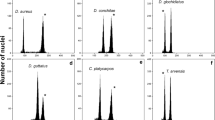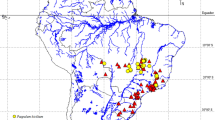Abstract
Twelve taxa belonging to two subsections of section Idaeobatus in Rubus L. from southwestern China were characterized by karyotypic, palynological, and random amplified polymorphic DNA (RAPD) data as follows: (1) The 12 taxa were all diploid species (2n = 2x = 14), among which the chromosome counts for R. mesogaeus var. oxycomus, R. subtibetanus, R. ellipticus var. obcordatus, R. inopertus var. echinocalyx, and R. stans were reported for the first time; (2) All taxa except for R. ellipticus and R. pinfaensis could be distinguished from each other by karyotype, pollen morphology, and RAPD markers. Karyotypes were mainly characterized by the difference in numbers and positions of submetacentric chromosomes and chromosomes with satellited pair, the index of the karyotypic asymmetry, and the ratio of the longest to the shortest chromosome. Pollen morphology were mainly characterized by the discrepancy in specific pollen size, P/E ratio, colpi width, distance between the apices of two ectocolpi, and exine ornamentation characters. The cluster results based on RAPD markers were consistent with morphology classification except for R. pinfaensis; (3) Based on the general data of karyotypic, palynological, and RAPD, R. ellipticus var. obcordatus should be treated as a species R. obcordatus, R. ellipticus and R. pinfaensis should be combined as R. ellipticus, and it was more reasonable to place the combinants and R. obcordatus into subsection Stimulantes rather than into subsection Pungentes.





Similar content being viewed by others
References
Erdtman G (1952) Pollen morphology and plant taxonomy—angiosperms. Almqvist & Wiksell, Stockholm
Focke WO (1910–1914) Species Ruborum. Monographiae generis Rubi Prodromus. Bibliotheca botanic 17 (72, part I):1–120 (1910); 17 (72, part II):121–223 (1911); 19 (83, part III): 224–488 (1914)
Gu Y, Wang CY, Zhao CM, Sang JZ, Li WL (1996) Evaluation of Rubus genetic resources. J Plant Res Environ 5:6–13
He SZ (2006) Rubus wuchuanensis S. Z. He, a new species of the Rosaceae from Guizhou, China. J Syst Evol (formerly Acta Phytotaxonomica Sinica) 43:345–347
Iwatsubo Y, Naruhashi N (1991) Karyomorphological and cytogenetical studies of Rubus parvifolius, R. coreanus and R. × hiraseanus (Rosaceae). Cytologia 56:151–156
Iwatsubo Y, Naruhashi N (1992) Cytotaxonomical studies of Rubus (Rosaceae) I. Chromosome numbers of 20 species and 2 natural hybrids. J Jpn Bot 67:270–275
Iwatsubo Y, Naruhashi N (1993) Cytogenetical studies of Rubus × tawadanu (Rosaceae). Cytologia 58:2175–2221
Iwatsubo Y, Naruhashi N (1996) Cytogenetic relationship between Rubus croceacanthus and R. minusculus (Rosaceae). Cytologia 61:163–167
Iwatsubo Y, Naruhashi N (1998) Cytogenetic studies of natural hybrid, Rubus × hiraseanus, and artificial hybrid between R. coreanus and R. parvifolius (Rosaceae). Cytologia 63:235–238
Jinno T (1958) Cytogenetic and cytoecological studies on some Japanese species of Rubus (I. Chromosome). Bot Mag (Tokyo) 71:15–22
Lauener LA (1970) Catalogue of the names published by Hector Leveille. VI. Notes from the Royal Botanic Garden Edinburgh 30:239–294
Levan A, Fregga K, Sandlberg AA (1964) Nomenclature for centromeric position on chromosomes. Hereditas 52:201–210
Li WL, He SA (2001) Taxonomic revision on several taxa in the genus Rubus (Rosaceae). Bull Bot Res 21:249–346
Li XL, Song WQ, Chen RY (1993) Studies on karyotype of some berry plants in north china. J Wuhan Bot Res 11:289–292
Li WL, He SA, Gu Y, Shu P, Pu ZM (2001) Pollen morphology of the genus Rubus from china. J Syst Evol (formerly Acta Phytotaxonomica Sinica) 39:234–247
Li WL, Gu Y, He SA, Zhang ZD (2002) Applicability of RAPD to systematics and genetic diversity of Rubus L. Acta Hortic 585:139–142
Longley AE, Darrow GM (1924) Cytological studies of diploid and polyploid forms in raspberries. J Agric Res 27:737–748
Lu LT (1983) A study on the genus Rubus of china. J Syst Evol (formerly Acta Phytotaxonomica Sinica) 21:13–25
Lu LT (2000) Notes on species of some genera of Rosaceae, China. J Syst Evol (formerly Acta Phytotaxonomica Sinica) 38:276–281
Malik CP (1965) Cytology of some Indian species of Rosaceae. Cytologia 18:139–149
Naruhashi N, Iwatsubo Y, Peng CI (2002) Chromosome numbers in Rubus (Rosaceae) of Taiwan. Bot Bull Acad Sinica 43:193–201
Pool PA, Ingram R, Abbott RJ, Jennings DL, Topham PB (1981) Karyotype variation in Rubus with particular reference to R. idaeus L. and R. coreanus Miquel. Cytologia 46:125–132
Punt W, Hoen PP, Blackmore S, Nilsson S, Thomas AL (2007) Glossary of pollen and spore terminology. Rev Palaeobot Palynol 143:1–81
Stebbins GL (1971) Chromosomal evolution in higher plants. Edward Arnold, London
Subramanian D (1987) Cytotaxonomic studies of South Indian Rosaceae. Cytologia 52:395–403
Thompson MM (1995) Chromosome numbers of Rubus species at the National Clonal Germplasm Repository. Hortscience 30:1447–1452
Thompson MM (1997) Survey of chromosome numbers in Rubus. Ann Missouri Bot Garden 84:128–164
Thompson MM, Zhao CM (1993) Chromosome numbers of Rubus species in Southwest China. Acta Hortic 352:493–502
Tomlik WA, Ham RW, JM Kosin′ski P (2004) Pollen Morphology of genus Rubus L. (III): studies on the Malesian species of subgenus Chamaebatus L. and Idaeobatis L. Acta Soc Bot Poloniae 73:207–227
Van Thuan N (1968) Flore du Cambodge, du Laos, et du Vietnam. Fascicule 7: Rosaceae II (Rubus). Museum National d’Histoire Naturelle, Paris
Yü DJ, Lu LT, Gu CZ, Guan KJ, Li CL (1985) Flora Reipublicae Popularis Sinicae (vol 37). Science Press, Beijing, pp 10–218
Zhou YQ (2005) Application on DNA molecular markers technology in plant study. Chemical Industry Press, Beijing
Acknowledgments
The authors are thankful to the Program for the National Natural Science Foundation of China (30671454) and the Education Bureau of Sichuan Province, China for financial support (2004A025). We particularly thank Prof. Guang-hui Yang (Sichuan Agricultural University) for her help in the course of specimen identification.
Author information
Authors and Affiliations
Corresponding author
Rights and permissions
About this article
Cite this article
Wang, XR., Tang, HR., Zhang, HW. et al. Karyotypic, palynological, and RAPD study on 12 taxa from two subsections of section Idaeobatus in Rubus L. and taxonomic treatment of R. ellipticus, R. pinfaensis, and R. ellipticus var. obcordatus . Plant Syst Evol 283, 9–18 (2009). https://doi.org/10.1007/s00606-009-0190-8
Received:
Accepted:
Published:
Issue Date:
DOI: https://doi.org/10.1007/s00606-009-0190-8




